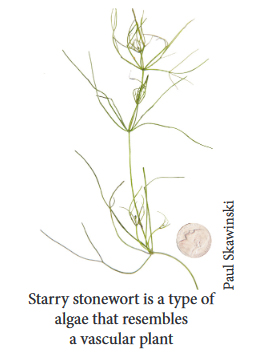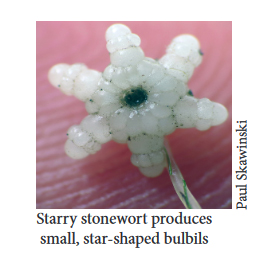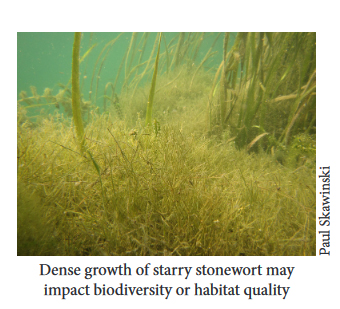Starry Stonewort (Nitellopsis obtusa (N.A. Desvaux) J. Groves)
Frequently Asked Questions
What is starry stonewort?
 Starry stonewort (SSW) is a type of large, green algae that superficially resembles a vascular plant. It occurs submersed in lakes, ponds, and slow-moving water bodies, anchored to the sediments with clear filaments called rhizoids. These rhizoids resemble fishing line and produce starchy growths called bulbils (see below). Starry stonewort can grow up to 7 feet (2 meters) tall.
Starry stonewort (SSW) is a type of large, green algae that superficially resembles a vascular plant. It occurs submersed in lakes, ponds, and slow-moving water bodies, anchored to the sediments with clear filaments called rhizoids. These rhizoids resemble fishing line and produce starchy growths called bulbils (see below). Starry stonewort can grow up to 7 feet (2 meters) tall.
How and when did it get to the U.S.?
It is unknown how SSW was transported to the U.S. It is likely that it initially arrived in ballast water of trans-oceanic ships from Europe. The first documented U.S. population was in 1978 (Geis et al. 1981) in the Saint Lawrence River between New York and Ontario, Canada. SSW is currently known from Indiana, Michigan (Lower), Minnesota, New York, Ohio, Pennsylvania, Vermont, and Wisconsin, and Ontario, Canada.
How does it spread from lake to lake?
It is unknown how SSW is transported between water bodies. Some aquatic plants and algae can be transported by waterfowl consuming their reproductive structures (seeds). However, there is an apparent absence of female SSW in North America, which would be necessary to produce viable “seeds” (oospores). There is no evidenceof starry stonewort being spread by waterfowl in North America. Without oospore production (due to a lack of females), SSW can still reproduce by fragmentation of the stem and by specialized structures called bulbils. These bulbils are star-shaped, creamy white, and less than 1/3-inch (~1cm) across. A single plant can produce many bulbils, and each bulbil can produce many new plants. Physical transport of bulbils or fragments is the most likely way that SSW is being transported, especially by boats, trailers, anchors, and other equipment. Early populations of SSW are often discovered adjacent to boat landings and other public access points. It is also possible that fragments of SSW could spread within a lake or between connected water bodies by water currents.
How can we control it?
 Many attempts have been made to control SSW, including application of aquatic herbicides and physical removal in lakes and ponds. Studies in several states are underway to evaluate outcomes of these management actions. Reports from lab-based trials indicate a decrease in biomass when SSW fragments are treated with copper algaecides. Controlled field-based trails are underway to assess the use of copper algaecides for SSW control, and preliminary results are inconclusive.
Many attempts have been made to control SSW, including application of aquatic herbicides and physical removal in lakes and ponds. Studies in several states are underway to evaluate outcomes of these management actions. Reports from lab-based trials indicate a decrease in biomass when SSW fragments are treated with copper algaecides. Controlled field-based trails are underway to assess the use of copper algaecides for SSW control, and preliminary results are inconclusive.
As with all invasive species, prevention and early detection remain the best options. Cleaning boats and equipment thoroughly is key to preventing spread of SSW to new locations. Photos and physical specimens of suspected SSW should be sent to an expert for verification. See the list of
experts at the end of this document.
Do we have a biological control agent available?
Biological control has shown mixed results for management of aquatic invasive species. There are no known biological control agents available for control of SSW.
What are the impacts of SSW on a lake?
Dense growth of SSW can interfere with boating, fishing, and other recreational activities. There is concern that SSW may displace other aquatic plants and reduce biodiversity, but this has yet to be confirmed by any scientific studies. It is commonly stated that SSW could affect quality
of fish habitat. Again, studies are currently lacking to evaluate this claim.
How deep will it grow?
 SSW can colonize shallow to deep waters up to at least 20 feet (6.1 meters) deep. It may reach the surface at depths up to 7 feet.
SSW can colonize shallow to deep waters up to at least 20 feet (6.1 meters) deep. It may reach the surface at depths up to 7 feet.
What type of habitat does it prefer to grow in?
SSW occupies a broad range of habitats. It particularly thrives in alkaline, stagnant to slow-moving waters with moderate to high levels of nutrients and calcium.
This document was prepared by the Nitellopsis Working Group, an international collaborative formed to compile sound information about starry stonewort.
Nitellopsis Working Group Members:
Anna Monfils, Ph.D., Central Michigan University, monfi1ak@cmich.edu
Aurelie Boissezon, Ph.D., DEFSE and ISE, University of Geneva, Switzerland.
aurelie.boissezon@hesge.ch
Blake Cahill, Central Michigan University, cahil1bc@cmich.edu
Chip Welling, Minnesota Department of Natural Resources, chip.welling@state.mn.us
Daniel Larkin, Ph.D., University of Minnesota - Minnesota Aquatic Invasive Species Research Center, djlarkin@umn.edu
Kenneth Karol, Ph.D., New York Botanical Garden, kkarol@nybg.org
Paul Skawinski, University of Wisconsin – Stevens Point, pskawins@uwsp.edu
Robin Sleith, New York Botanical Garden, rsleith@nybg.org
